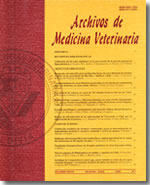Consequences of self-fertilization on the growth rate and survival of Argopecten purpuratus
Main Article Content
Abstract
The Northern scallop, Argopecten purpuratus, is a hermaphrodite species which has a great economical importance in Chile and Perú. Hatchery techniques for juvenile production have been developed for this species, allowing the study of the potential effect of self-fertilization in the aquaculture of the Northern scallop. The present study produced several families of A. purpuratus in a hatchery using a factorial design, which allowed the statistical analyses of growth and survival of each family, with variable initial self-fertilization percentage. On the other hand, PCR-based molecular markers (RAPD) were developed which allowed the identification of self-fertilized individuals within each family. The percentage of self-fertilization was estimated initially and at 6, 9 and 12 months of age, observing a significant reduction of it in each of the experimental families. The results obtained allowed us to conclude that even if the self-fertilization has a negative effect on the development of the Northern scallop, this is only at individual level, affecting the growth and survival of the individuals which have been produced under that condition. However, those families produced by crossfertilization, which have variable self-fertilization percentages among them, are not significantly affected on their growth and survival, because the self-fertilization percentage is reduced gradually with the age of the individuals.

